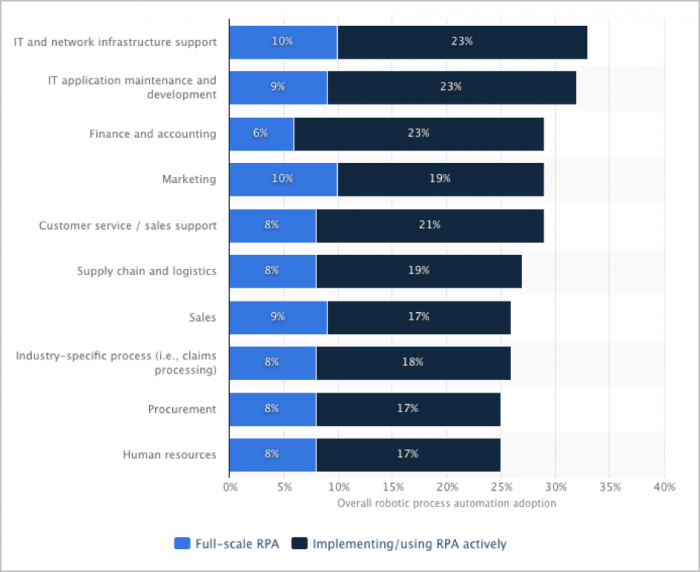Robotic process automation (RPA) will significantly change the workplace culture in the coming years. In this article we would like to give you some examples on the effect of RPA on different business sectors. Robotic process automation by machine learning and software as a service solution (SaaS) definitely have the potential to effect many different industries and to disrupt the labour market. It will be interesting to study the different implications on business sectors and the impact that RPA can have on the industry you work in.
Robotic process automation (RPA) adoption worldwide in 2015, by department
Source: Statista (2017a) (online), https://www.statista.com/statistics/647092/worldwide-robotic-process-automation-adoption-by-department/
On the graphic above you will find the Robotic process automation adoption across different departments worldwide among buyers of business process outsourcing buyers surveyed in 2016. All the presented departments have been evaluated based on the two different categories, Full-scale RPA and Active RPA implementation. The bar chart shows that Full scale RPA, the complete automation of processes is quite equally distributed among the different departments. Marketing and IT and network infrastructure support account for a 10% integration rate which is the highest score for the full-scale RPA. Most other departments score at 8-9% and Finance and accounting has a significantly lower rate of 6% which is surprising due to the technical and repetitive task nature of accounting services. However, Finance and accounting have the highest rate of partial RPA (23%) which puts the department still at the third position overall for the most automated departments.
IT services generally have the highest overall RPA integration with strong full scale- as well active partial RPA. On the other end of the scale, procurement and human resources account for lower automation rates. The statistic shows that the nature of the job task and department characteristics show differences and certain jobs are effected more than others.
Size of the information technology (IT) robotic process automation (RPA) market for worldwide from 2012 to 2020 (in million U.S. dollars)
Source: Statista (2017b) (online), https://www.statista.com/statistics/647202/worldwide-robotic-process-automation-market-revenues/
This statistic has been brought to you by Thoughtonomy.
On this statistic the size of the robotic process automation (RPA) market is presented based on statistical coverage in the year 2016 including projections for the years 2017-2020. The diagram shows exponential growth rates and projects massive growth of RPA in the short term over the next four years. This trend shows that the major impact of RPA is still to come and the information technology for automation will still be advanced significantly in the years ahead.
With this data and developments in mind, employers as well as employees should definitely have a look at this issue with potential for major societal disruptions. The statistic above has shown that certain departments are effected more than others and the impact scale of robotic automation is dependent on different types of business operations. It will be interesting to monitor the developments that take place in the job market over the next time and how the predictions actually turn out to be. The common apprehension that robots will cause job cuts is certainly sth. to observe in future. It must be awaited if the predictions actually become reality, but one thing can be sure: Robotic process automation has the potential to change the labour market unlike any other societal trend and creates new opportunities for businesses to become more efficient and for employees to facilitate work tasks tremendously.
Find a Home-Based Business to Start-Up >>> Hundreds of Business Listings.

















































